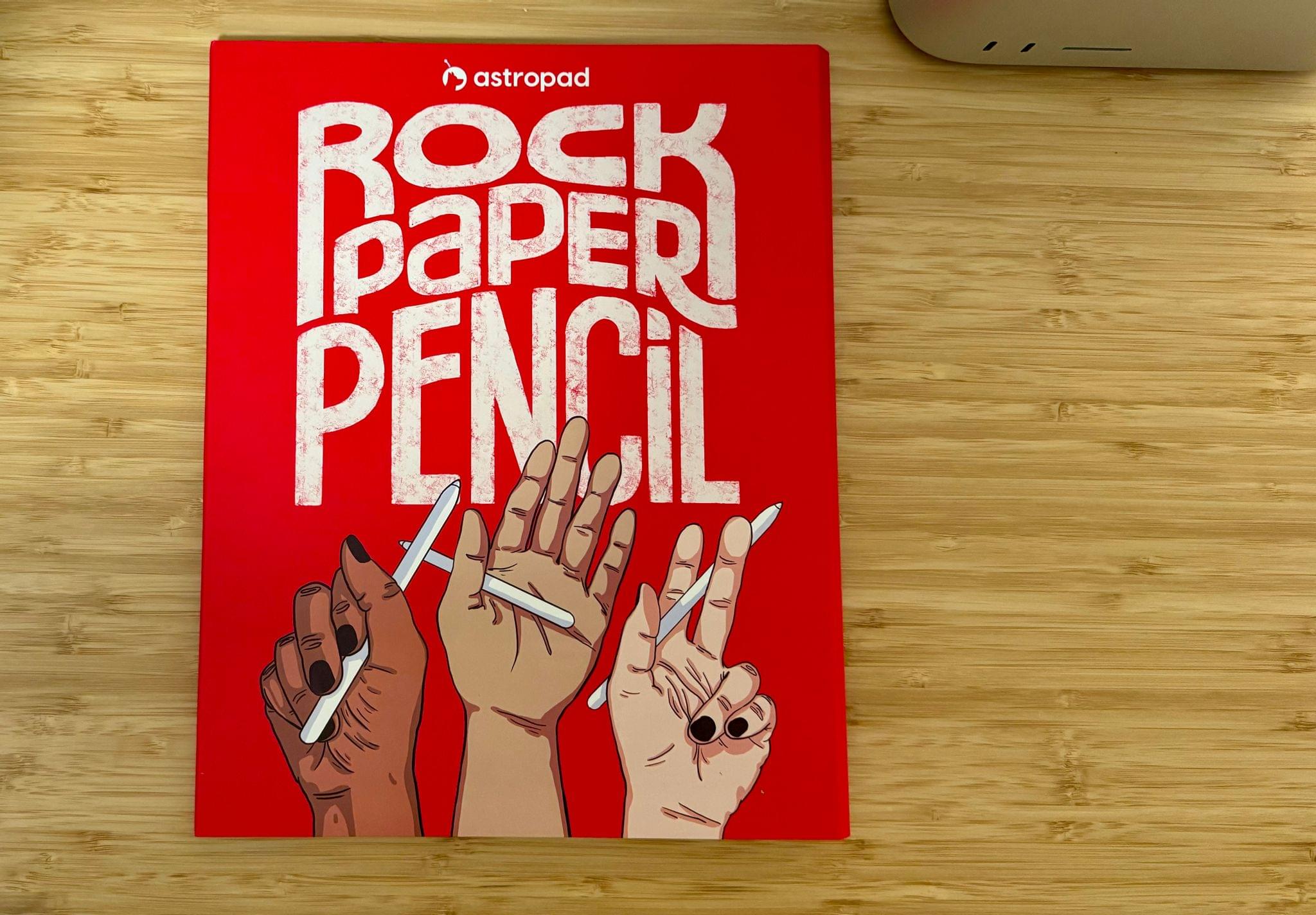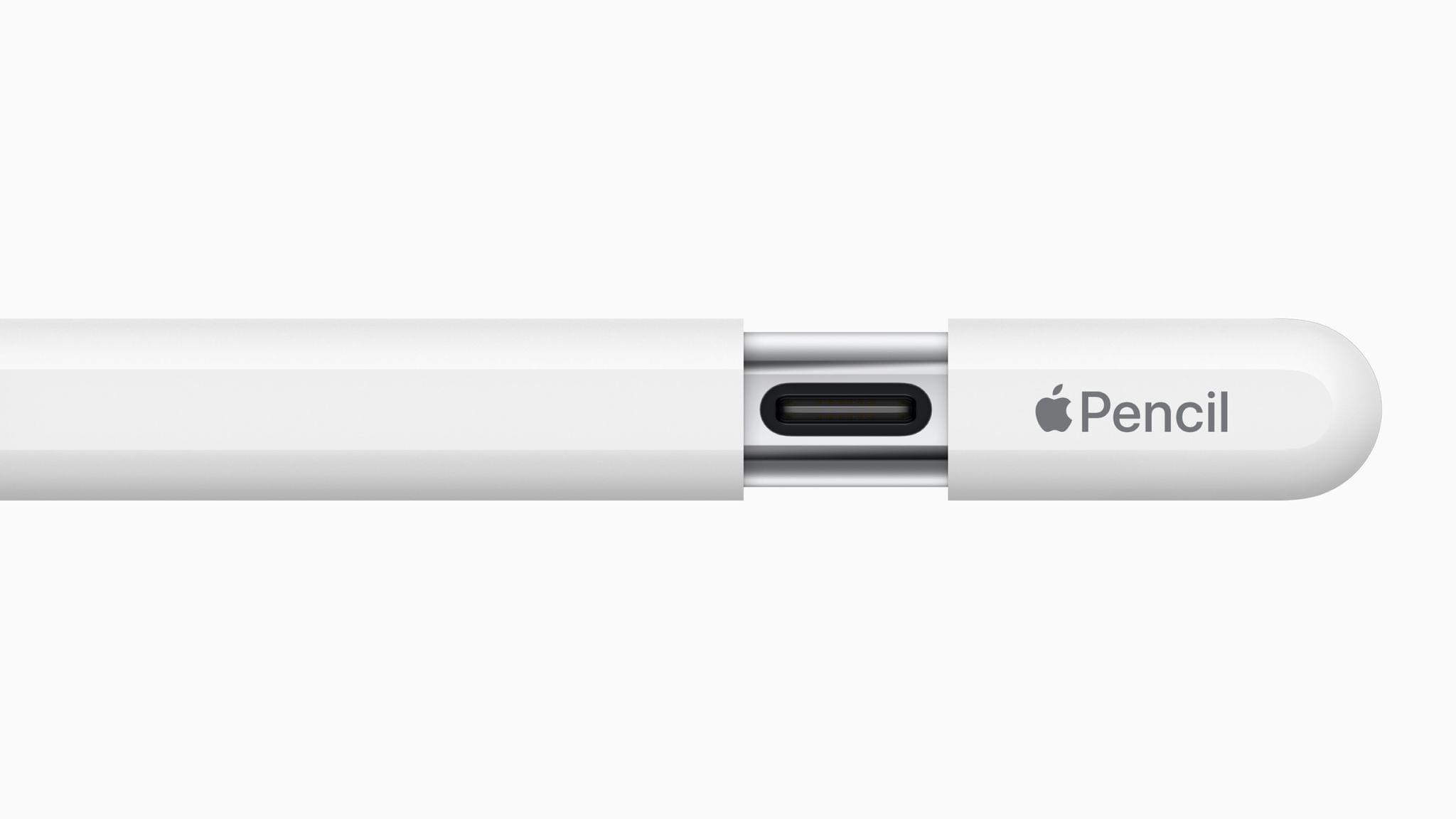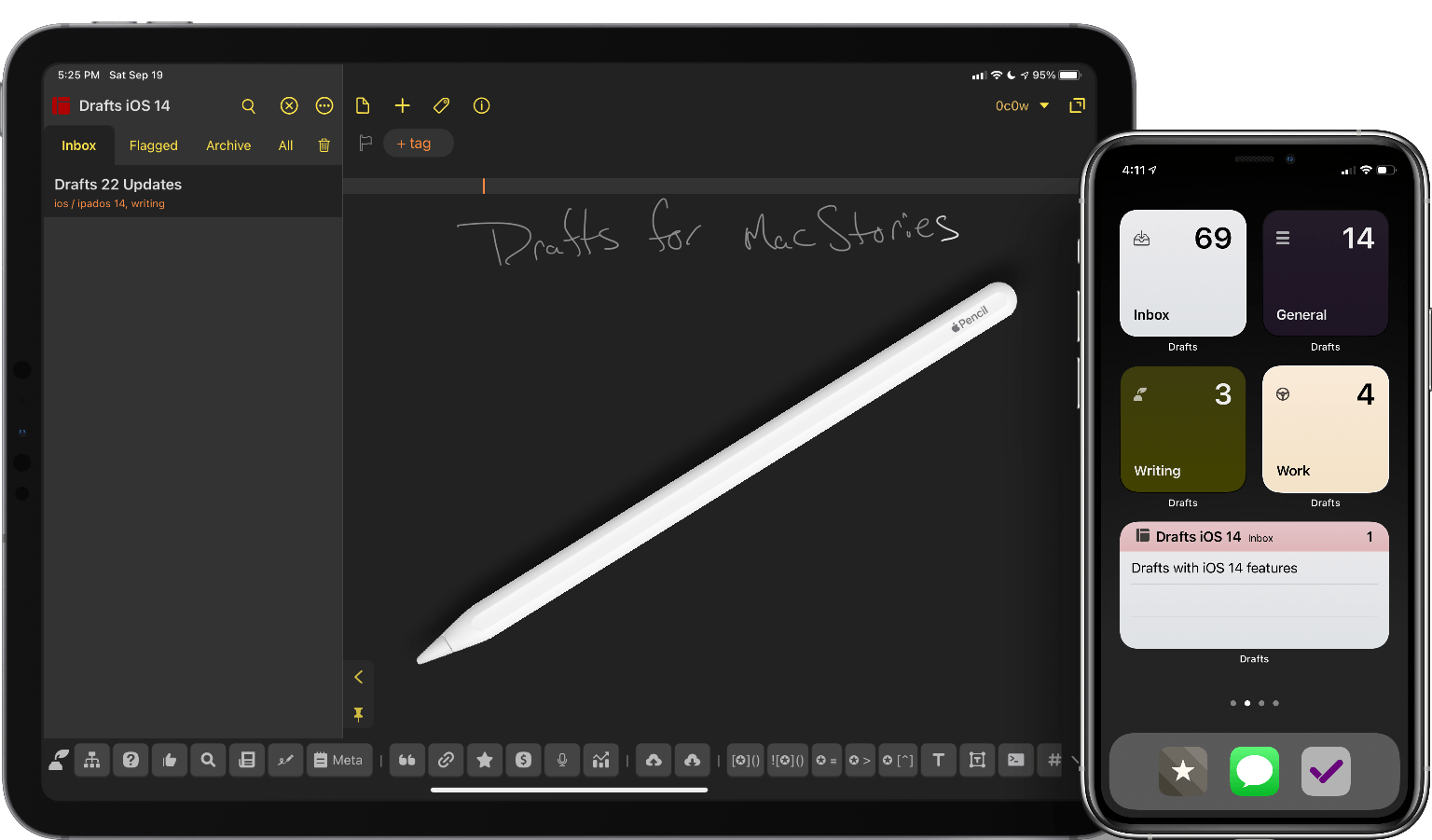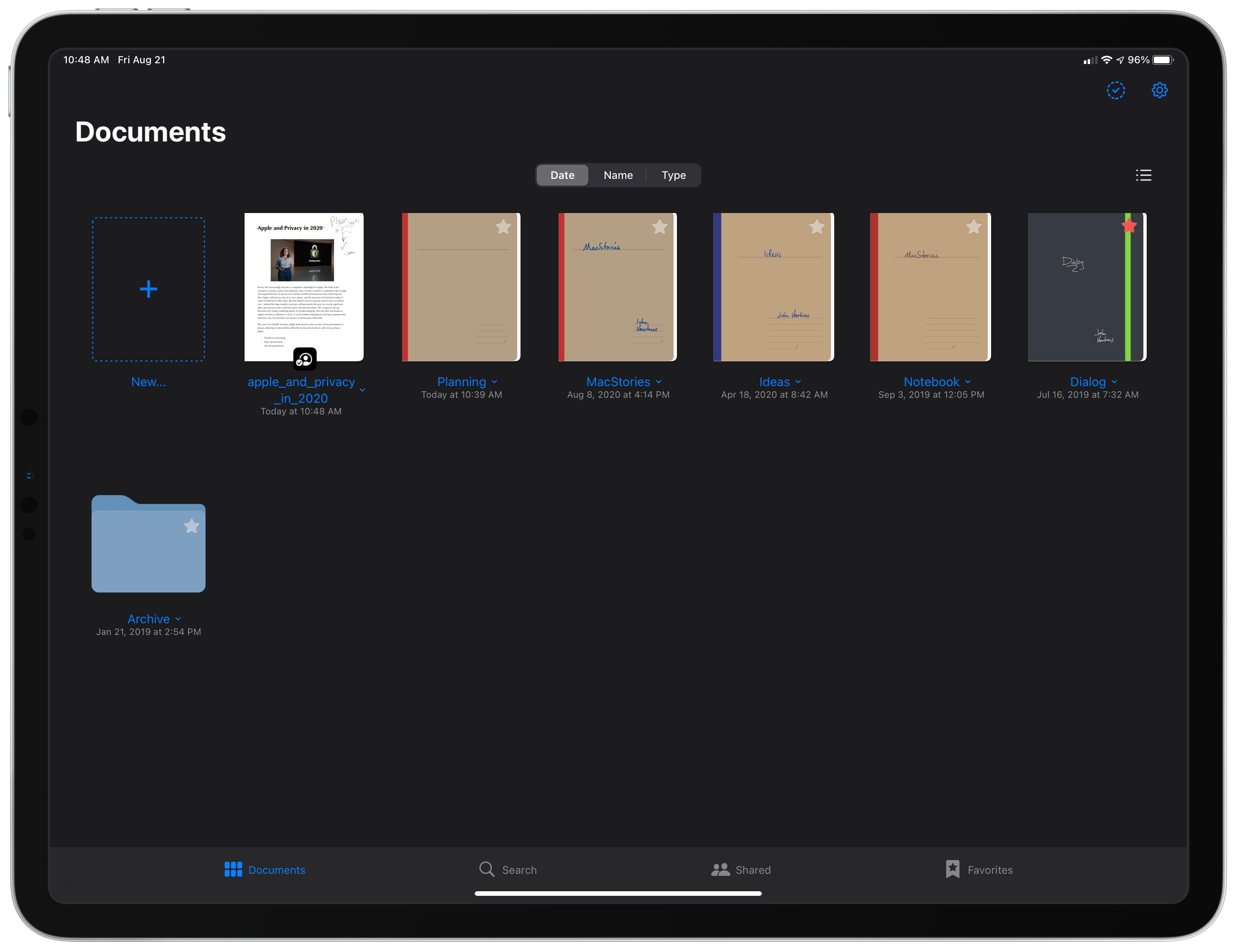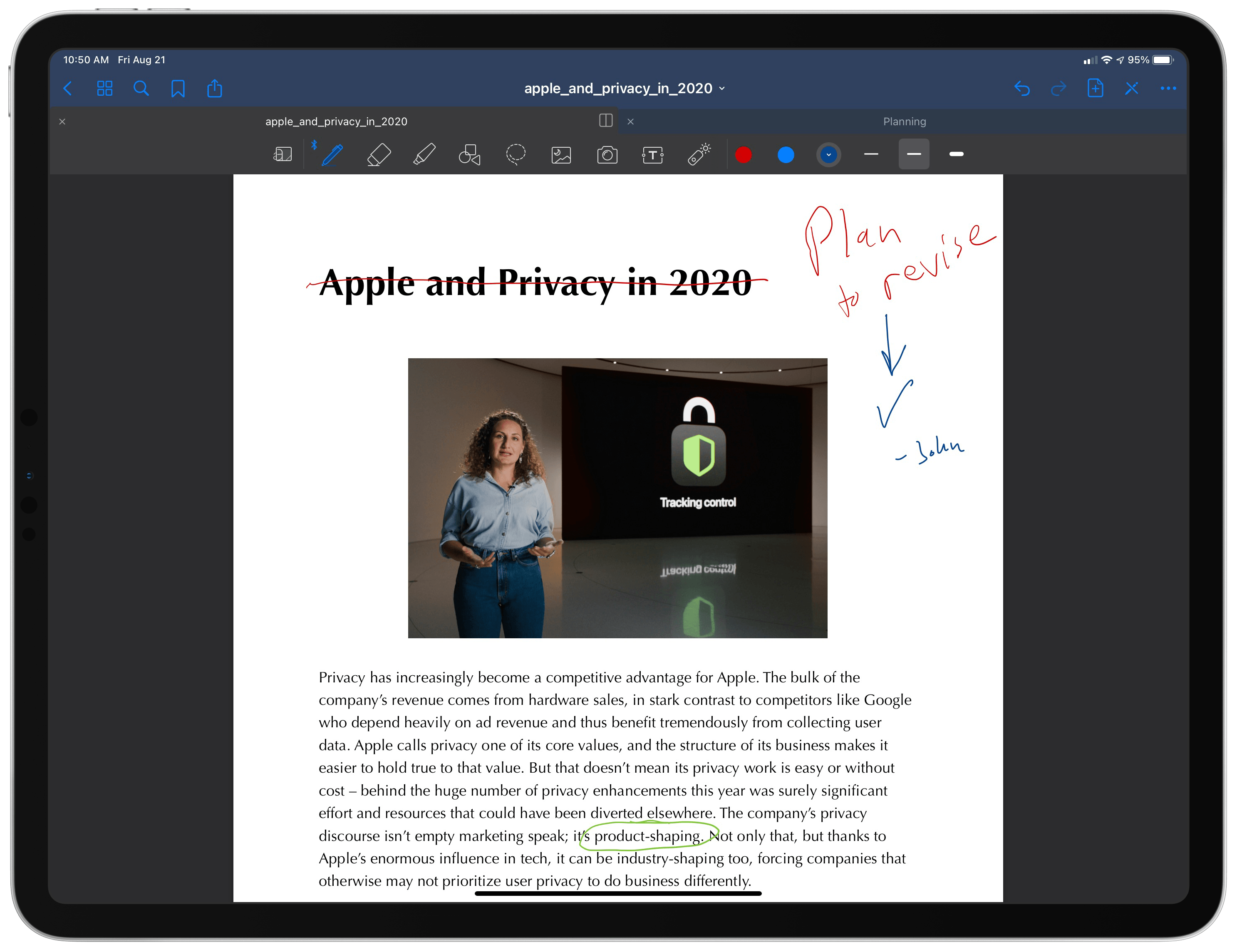It’s been years since I took a serious run at handwritten notes on the iPad. However, that changed with my recent experiments with the Boox Tab Ultra, which led me back to the benefits of jotting down handwritten notes as a quick capture system while I work. That’s why Aspropad’s new Rock Paper Pencil bundle of a nano-textured iPad screen protector and replacement Apple Pencil tips that mimic the feel of paper caught my eye. I’ve had bad luck with screen covers that feel like paper in the past, but as I’ll explain below, Astropad has created a unique package that offers the closest experience to writing or drawing on paper that I’ve ever tried while also being easy to use.
Posts tagged with "Apple Pencil"
Astropad’s Rock Paper Pencil Delivers A No-Compromise, Simple Paper-like Experience on iPad
Apple Announces a New, More Affordable Apple Pencil That’s Coming in November
Today, Apple unveiled a new, more affordable Apple Pencil that charges via USB-C and supports many of the features of the two previous-generation Apple Pencils, but not all of them.
The new USB-C model looks a lot like the second-generation model, except it doesn’t charge wirelessly. Instead, the end of the Pencil can be pulled back to reveal a USB-C port for charging. However, like the second-generation Pencil, the new model attaches magnetically to the side of compatible iPads, which puts the Pencil into sleep mode to preserve battery power.
The latest Pencil also supports tilt sensitivity and hover, which was introduced with the latest iPad Pro models, but pressure sensitivity and double-tap to switch tools are not supported. Apple isn’t offering free engraving, either.
The new Apple Pencil is $79 ($69 for education) and will be available beginning in early November. According to Apple’s press release, the accessory is compatible with all iPad models that have a USB-C port, including iPad (10th generation), iPad Air (4th and 5th generations), iPad Pro 11-inch (1st, 2nd, 3rd, and 4th generations), iPad Pro 12.9-inch (3rd, 4th, 5th, and 6th generations), and iPad mini (6th generation).
The New iPad and iPad Pro Review: Mixed Signals
Last week on Thursday, I received review units of the new 10th generation iPad and 6th generation iPad Pro. I’ve spent the past few days testing and getting work done with both of them – including finishing a big story about Stage Manager I’m going to publish in a few hours on MacStories.
These are relatively easy iPads to review with a fairly straightforward narrative around them. The new iPad Pro is an iterative update that shows us Apple has seemingly hit a plateau in terms of innovation with this particular design – save for one feature that truly surprised me. The new base model iPad is a massive update compared to its predecessor, adding an all-new, iPad Pro-inspired design and a brand new accessory – the Magic Keyboard Folio – that has turned out to be one of my favorite accessories Apple has launched in recent years. I’ve had a ton of fun playing around and working with the new iPad over the weekend; if you’re in the market for an 11” tablet, you shouldn’t sleep on this one.
When considered individually, these new iPads are solid options in their respective categories – each delivering on the different goals Apple set out to accomplish for these product lines in 2022.
It’s when you zoom out and take a broader look at the new state of the iPad lineup that things become…a bit more confusing.
Fantastical Debuts Powerful, Versatile Widgets Alongside Scribble for iPad
Time itself has been under attack in this year of infamy. In some ways 2020 has felt like an eternity, but somehow, simultaneously, it’s shocking that we’re nearing the end of it. Our days have lost so much of the structure and the rhythms we’re used to, resulting for some people in days that are long and void of much activity, while others are overwhelmed in a different way as they juggle work with caring for their children, facilitating virtual school, and of course hopping on too many Zoom calls per day. Whatever your situation may be, your concept of time has likely been thrown off-kilter this year.
Yet time marches on. And for many of us, the assaults on our normal patterns of life have required building new patterns, new structures for our weeks and days so we can find a new sense of normal. Rather than abandon our calendars, we perhaps need to be more judicious with them than ever. Which is where Fantastical with its new iOS 14 widgets and Scribble support comes in.
Drafts 22 Review: Widgets, Scribble, and More
One of my favorite times every year is right around the beginning of August. Not because of the weather – summer where I live – but rather it’s when beta season is in full swing. Apps are putting polish on features, the full update scope is set, and everything starts to feel stable. And there’s nothing better to me than a new Drafts update to coincide with new OS features, bringing new uses of the app to my répertoire.
With the release of iOS and iPadOS 14 this year, it might seem on the surface that the updates to most apps are minimal. Widgets are the hot new feature of the operating systems, along with the visual changes of macOS Big Sur. While most apps will benefit from these changes, the productivity category will be greatly helped. And like Shortcuts, Scriptable, and others, Drafts benefits greatly from these new changes. It might take you a bit of time to see how this will fit your use cases, but once you give that some thought, it will open up new opportunities for you to use the app.
GoodNotes Launches iCloud Document Collaboration
One of the tech trends I expect has been accelerated by the current state of the world is a demand for collaboration features in software. On Apple’s platforms the company offers its native iCloud collaboration features that apps can adopt, and which are also available in first-party apps like Notes, Reminders, and the iWork suite. While iCloud doesn’t provide the kind of instant, real-time collaboration found with a service like Google Docs, the undisputed king of this domain, it’s nonetheless a solid option that provides valuable utility in apps that support it.
The latest app to add iCloud collaboration is GoodNotes, which in today’s version 5.5 enables you to share documents with other GoodNotes users so you can work together in the same document at once. The way this works is simple: from your documents library, tapping a document’s title will open a context menu where Collaborate is a new option; or, while working in a document, tapping the share icon will also reveal the Collaborate option. Like other apps supporting iCloud collaboration, the feature works by generating a link which grants collaborators access to the shared files, provided they have the source app installed. In this case, anyone who has the link can access the file. Once a document has been shared, it will be badged with a special icon in your library, and all shared documents are additionally housed in a new Shared tab in GoodNotes’ navigation bar.
Collaboration means that multiple people work in a document at once making their own annotations and changes, though there will regularly be a delay of 15-30 seconds before changes appear for all users. As such, GoodNotes’ collaboration doesn’t serve as a replacement for more real-time solutions such as collaborative whiteboard apps, but rather it’s better suited for situations where changes are made over an extended period of time. For example, sharing meeting notes before or after a meeting takes place to get feedback from your team, or letting multiple people annotate a draft-in-progress. As an app, GoodNotes offers tools for a range of use cases in areas of business, education, or personal uses, so there will likely be lots of scenarios where the new collaboration option is valuable despite lacking real-time updates. When there is an update to a shared document, you’ll be notified via a blue badge accompanying the document in your library, which can also inform you of which page in the document received changes.
Besides the slow sync time, another key limitation I discovered in my testing is that GoodNotes doesn’t offer a way to identify who made which annotations in a document. Unlike an app like Apple Notes, where you can choose to highlight the text written by each collaborator, there’s no such equivalent feature built-in here. What this means is that if you want to know who is responsible for certain notes or changes, you’ll need to coordinate with collaborators ahead of time and ask them to use specific colors so you know who is who, or else everyone will need to find a different identifying method such as initialing every annotation. Hopefully this drawback will be resolved in a future update. Finally, it’s also worth noting that collaboration features currently don’t work for managed Apple IDs, such as those commonly employed in schools.
Collaboration is such an important feature in 2020, and Apple’s current APIs for iCloud collaboration have been adopted by so few apps, that it’s always nice to see a new one add it. The limitations aren’t great, but my hope is that today’s release should be considered more a 1.0 of collaboration rather than the final version. If GoodNotes’ team (or Apple, via API improvements) can cut down on the lag between changes syncing among collaborators, and can offer a native way to know who made which changes, collaboration could become a key differentiator for the app. Even without those potential enhancements though, in 2020 the addition of collaboration is a valuable asset for any app, and GoodNotes is no exception.
Jason Snell on Editing Podcasts with Ferrite on an iPad with the Apple Pencil→
Jason Snell has edited a lot of podcasts. In fact, The Incomparable, the flagship show of his media and pop culture podcast network of the same name, just reached episode 500.
Since last summer, Snell has been using Ferrite by Wooji Juice to edit nearly every episode of The Incomparable on his iPad with the Apple Pencil. I’ve heard him describe his iPad and Apple Pencil workflow on podcasts before, but there’s nothing like seeing it in action, which you can now do on the Six Colors YouTube channel.
What struck me most about Snell’s video is how natural direct manipulation of multiple audio tracks looks. I’ve always done all of my podcast editing on a Mac with Logic Pro X, but after watching Snell edit an episode with multiple guests, I look forward to trying this myself.
Linea Sketch Adopting Subscription Model in 2020→
The Iconfactory has announced that Linea Sketch, its popular iPad sketching app, will be moving from paid up front to a subscription business model. This transition will take place in early 2020 with the release of Linea 3.0.
We tried hard to avoid a subscription, but the costs to maintain the app are much higher than the income from new sales. This is obviously not a sustainable situation! We have two options:
- Let the app die a slow, painful, and unsupported death
- Find a source of recurring revenue
They mention that the recent 2.7 update to Linea took over 200 hours of work, and most of that time was simply spent adapting the app to work well with iOS 13’s new system dark mode. The cost of simply maintaining the app to function well with system updates is high, and The Iconfactory wants to do much more than just maintain the app. For example, they preview the roster of changes coming to Linea 3.0, which will include a universal app across iPad and iPhone, and the following:
- Time-lapse to capture your creation as it evolves
- Templates with adjustable intensity
- Custom backgrounds with adjustable paper color and texture
- App themes and beautiful new app icons for your home screen
- QuickToggle: two-handed drawing is all we’re going to say :-)
Linea’s subscription will cost $.99/month or $9.99/year, and include both the iPad and iPhone versions of Linea, since the two will become a universal app. On a related note, the Mac companion app Linea Link is now available as a free download.
Many users hate seeing the apps they use switch to subscriptions, but sometimes developers truly don’t have much of a choice. As was mentioned above, development costs for Linea are currently much higher than sales revenue, which is clearly an unsustainable situation. Either The Iconfactory finds a sustainable option for Linea, or the app will eventually disappear. And because of Apple’s unwillingness to allow upgrade pricing on the App Store, subscriptions are one of the only viable options.
Adobe Previews New iPad Drawing and Painting App, Fresco→
Last year around the time Adobe began detailing its forthcoming Photoshop for iPad, the company also shared word of another iPad app it was working on, then called Project Gemini. Today in a blog post, Scott Belsky of Adobe announced Adobe Fresco as the official name of the new drawing and painting app, and detailed one of the features that will make the new app special:
The result is Live Brushes, which use the artificial intelligence of Adobe Sensei to recreate the behavior of oils and watercolors in an amazingly lifelike way. When you paint with a watercolor Live Brush, you’ll see the color bloom into adjacent areas of the paper. Use red and yellow next to each other and they’ll naturally blend into orange at the border. You can even recreate painting with water to dilute some colors and encourage tints to mix.
With an oil Live Brush, you can slather on a thick coat of paint and see the ridges and brush strokes that give the painting dimension. And you can mix different oil colors together to create a varied swirl of color that no digital color wheel could ever provide.
Live Brushes can be seen in action in the video embedded below. Adobe’s aim with Fresco is to provide a tool that scales well in serving users who want a simple drawing tool to those who need the power of features like layers, masking, brush creation, and more. While it’s expected that Creative Cloud subscribers will receive full access to Fresco’s full feature set, Adobe seems to be considering its full spectrum of target users when it comes to pricing. In today’s announcement Belsky notes “anyone with the right hardware will be able to draw and paint in Fresco for free.”
No update was given on Fresco’s release date, other than that it remains “later this year.” With iPadOS 13, Fresco, Photoshop, and the iPad app improvements that are hopefully to come alongside Catalyst projects, it’s going to be an exciting end of the year for iPad.


